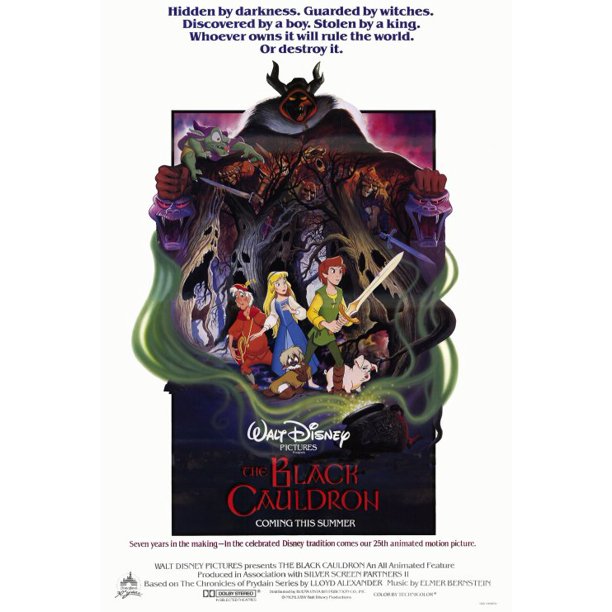
Disney’s THE BLACK CAULDRON was released 35 years ago today on July 24th, 1985. The rare Disney film to have an army of the undead and a horned necromancer, it stood out as possibly too dark for some audiences.
To celebrate this undervalued ghastly gem, what is your favorite kids’ movie with scary elements? (Or your favorite movie you watched as a child — maybe not intended for your age — with scary stuff in it?)

There’s the Cronenbergian transformation in Disney’s PINOCCHIO, the literal demonic clown nightmares of THE BRAVE LITTLE TOASTER and PEE-WEE’S BIG ADVENTURE, the headless enchantress from RETURN TO OZ, the weird séance in WATCHER IN THE WOODS, the uncanny valley freakishness of the flying monkeys of 1939’s THE WIZARD OF OZ, Hexxus the toxic monster in FERNGULLY, the actual backstabbing rat politics of SECRET OF NIMH, the instant-cyborg scene in SUPERMAN III, and so many more.
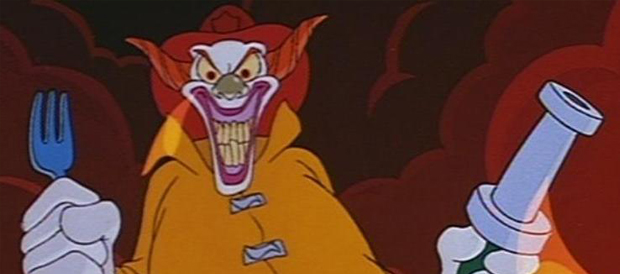

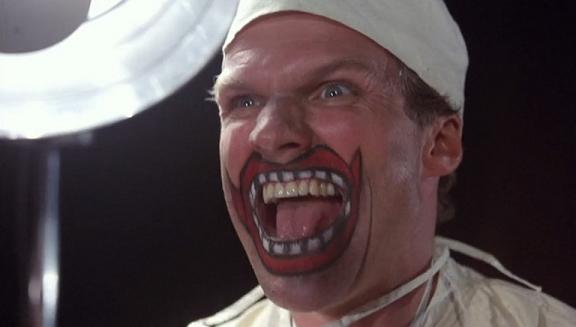
What scary scene or movie you watched as a kid has stayed with you all these years?

ROB DEAN
I love THE BLACK CAULDRON but it didn’t scar or terrify me like other movies I watched as a child. On an upcoming episode of the Scarred For Life podcast, I talk about how the wine-loving skeleton from THE LAST UNICORN haunted me. Or there’s Chamberlain in THE DARK CRYSTAL screaming “FRIENDS!!!!” at the Gelflings as they flee his creepy pleas. But a scene that truly haunts me and has stuck with me since I first saw it as a child is from 1978’s THE WIZ. Directed by Sidney Lumet with a screenplay from Joel Schumacher (loosely adapting the stage musical by William F. Brown and Charlie Smalls), THE WIZ was an EST-infused retelling of The Wizard Of Oz with an urban setting (and produced by Berry Gordy’s Motown Productions).
There are lots of great stylistic choices integrating the familiar tropes of Baum’s fantasy with the city-life of the ‘70s while often riding the line between social commentary and possibly offensive caricature. THE WIZ follows the basic story structure of Wizard Of Oz, with Dorothy (Diana Ross), Scarecrow (Michael Jackson), Tin Man (Nipsey Russell), and Cowardly Lion (Ted Ross) making their way through Oz to get solutions to their various problems.
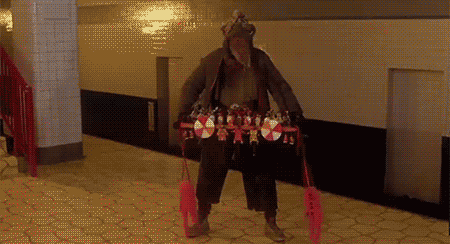
But there is a quick sojourn into a subway platform in which it suddenly turns bone-chillingly nightmarish. A street vendor approaches the travelers with some little dolls he has performing for them… who soon grow larger and larger, all to a creepy synth/calliope beat that oozes dread. The scene also features garbage cans trying to eat Scarecrow, wires electrocuting Tin Man, and pillars coming to life and surrounding Dorothy to squash her — but all of those pale in comparison to the eerie, unnatural movement of these hideous paper monsters with their eternal grins and wordless march accompanied by this awful music and the sinister laughter of the street vendor.
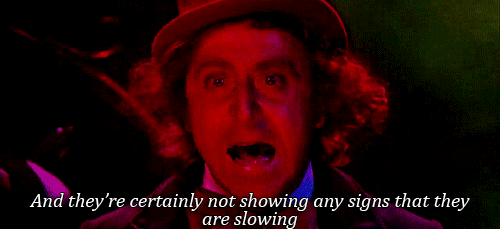
CRAIG EDWARDS
My memory, always fairly subjective, tells me that WILLY WONKA AND THE CHOCOLATE FACTORY was an annual staple for the NBC network, airing yearly on Thanksgiving night. The movie came out in 1971 so I’m guessing NBC wouldn’t have gotten the rights to it until at least 1974. Somewhere around that time or Thanksgiving 1975 I would have been still in single digits and playing with my cousins as my large family meal and get together would have been winding down. I’m guessing a big card game of Pitch was keeping the adults occupied so no one was making noises about leaving. Consequently my cousins and I, weary from running around the house, settled down to watch some television. WILLY WONKA started, and we stuck with it through the opening sequences, which are true to the book but remarkably dour and slow to catch the attention of a child, to be honest. Eventually young Charlie makes it to the chocolate factory and the movie picks up the pace considerably. My cousins and I were enjoying it, even as we were a little leery of Willy Wonka (the great Gene Wilder) himself. He was very strange and right from his first appearance even a tiny bit sinister. And then we got to the boat scene. In the story Wonka takes the people touring his factory on a boat ride down his chocolate river. Once on the boat it passes into a tunnel and the tourists (and the viewers) start to get nervous about the ride. Wonka’s monotonic speech/song about having no idea where they’re going or which way the river is flowing adds to the mounting fear, especially as it builds and builds to him shrieking the last few lines. While this has been building out of nowhere strange images appear around them, including a villainous-looking fellow we’ve seen lurking about and culminating in the decapitation of a chicken! This scene terrified me and my cousins, but at the same time completely enthralled us. (Also interesting – as far as I know NBC cut nothing from this scene, including the live chicken dying on camera.) I was already a veteran of the Universal Monsters movies airing on Creature Features on the weekends, so getting scared watching a movie was a new hobby. We finished the movie that night, and then repeated the experience for the next several years on each successive Thanksgiving night. If the parents broke up the party we would clamor to get home quickly so we could either watch or continue to watch the movie solo. I finally got to see the movie on the Big Screen a couple of years ago, and it was amazing to see this still unnerving sequence projected at that size. I can only imagine how it must have terrified kids in the audience in the theater in 1971. I wish I could have been there.

AUSTIN WILSON:
LADY IN WHITE (1988) is essentially a marathon of visuals that scared the entire crap out of me as a kid. Written and directed by Frank LaLoggia, it follows young Frankie Scarlatti as older Frank narrates the story of when he witnessed a murder and ended up getting haunted for his trouble.
Frankie is locked inside a school cloak room (it’s way bigger than just a closet) on Halloween day, tricked by two bullies, one dressed as the devil and played by reliably bratty Jared Rushton (BIG; HONEY I SHRUNK THE KIDS). He’s got his Dracula mask and his cape, but nothing else to keep him company. The sun is disappearing and there he is, trapped.
I don’t know why being in an empty school after hours was so creepy to me as a kid. Maybe it had something to do with those spaces normally being filled with noise, commotion, and unrelenting energy. To see them dark and silent meant they were wrong somehow, I was wrong somehow.
I was already scared from seeing Frankie trapped in his school after dark, from seeing the sun disappear and the graveyard visible through the half-moon window he huddles by. The blue light of nighttime shines through the window and then? Yeah, and then a ghost shows up.
At first, it’s fine, it’s the ghost of a little girl around his age. She’s playing, spinning around and singing — to someone we can’t see. It changes from fun and interesting really fast when she begins to get choked, and we still can’t see who is doing it. Frankie watches as she’s killed and dumped to the ground.
And then the cloak room door opens! Someone walks in, hidden in shadow, and begins to unscrew the metal register in the floor, searching for something. Frankie sits, frozen, watching.
Even though the movie is from 1988, that’s all I’ll say, because it could still hit someone reading this in ways I’d hate to ruin. The image of Frankie next to the glowing window, his mask pushed up and his fear solid in his joints has stuck with me for years. It certainly scared me for countless nights as a kid.
I’ve seen it somewhat recently, and although it doesn’t hold up for me it’s still an entertaining watch due to nostalgia. It has a Bradbury-esque glow about it, which I would only understand after I read The Halloween Tree around seven or so years after I watched this.

J. ALARY
Growing up, despite my parents’ best efforts, I detested Disney movies. All Disney movies—Mickey Mouse, Donald Duck, Fred MacMurray, and Dean Jones were not welcome in my house! My early childhood anti-Disney stance explains a lot about my misanthropic personality. Actually, I lied that I hated ALL Disney movies: I loved THE BLACK HOLE (and 20,000 LEAGUES UNDER THE SEA, but that didn’t traumatize me). Thanks to George Lucas, the late ‘70s/early ‘80s had a dizzying number of sci-fi spectacles, so the Mouse House got into the action with a visually spectacular, but narratively inept movie (and it’s woefully scientifically inaccurate, but I’m not Neil DeGrasse Tyson—I need my spaceship “whoosh” sounds). I could list any number of scenes from JAWS, or the shower scene from PSYCHO, but there’s a single scene in THE BLACK HOLE, unbeknownst to my parents, that terrified me, giving me nightmares for a week! THE BLACK HOLE has an impressive cast, even if there isn’t much to do but deliver choice lines like, “The word ‘impossible’, Mr. Booth, is only found in the dictionary of fools” or “If there is any justice at all, the black hole will be your grave!”. In addition to human actors, THE BLACK HOLE has a cutesy, telepathic robot, V.I.N.C.E.N.T. (I don’t even want to attempt to figure that acronym out), and a menacing, flying demonic robot, Maximilian. I cheered for evil characters in movies (I told you I’m a misanthrope), so he was a favorite (I also got a free Maximilian toy in a box of Shreddies, so that helped stoke my adoration for the crimson dynamo). Though I love his haughtiness, especially as he ignores his dying master’s pleas, it’s his attack on Dr. Alex Durant (Anthony Perkins) that unsettled me considerably. THE BLACK HOLE was Disney’s first “PG” movie, which was notable in 1979, and the Maximilian attack scene was pushing the PG rating, at least for my 6-year-old self. In addition to a glowing red “eye” and anti-gravity thrusters, Maximilian introduces arms that pop out of his metal torso, replete with whirling blades, as he swoops down to attack Durant. The poor doctor is only trying to help save his colleague, Dr. Kate McCrae (Yvette Mimieux), but, alas, he gets his torso ripped to shreds for his efforts. Anthony Perkins sells his death scene with alarming detail: jarring guttural sounds, grisly facial expressions, and spastic body movements. It’s a mercifully short scene, edited expertly, lest 1979 have TWO sci-fi-related chest trauma scenes deserving an “R” rating. Outside of xenomorph machinations, nobody died quite like Perkins in late ‘70s sci-fi and it’s courtesy of Disney. Thanks for the nightmares, Walt!

SCOTT RUSSELL
My lovely mother took me to see Tim Burton’s MARS ATTACKS in theaters, severely misunderstanding the movie’s entire vibe and/or the sensitivity of her six-year-old. Assessing the film now, I see a darkly comic tribute to the sci-fi films of yesteryear, but as a wide-eyed kid, I was not at all in on the joke—rather than recognizing the deliberately exaggerated cruelty of Burton’s Martians gleefully vaporizing people, I just took it at face value, which made for a uniquely upsetting experience.
I don’t recall minding MARS ATTACKS much until the scene in which the Martians first make contact, greeting America’s top general and claiming they come in peace. Someone in attendance releases a single dove in celebration, the music swells triumphantly, and there’s something about the suddenness with which the Martians turn heel, shooting the dove out of the sky, then turning their lasers on the humans, that disturbed me in a way even those humans’ actual dissolution into colorful skeletons couldn’t (though that didn’t help, either!). The Martians start blasting seemingly just because they feel like it, meeting humanity’s dim-witted optimism with a wanton, crushing “fuck you.”
I hung in there as long as I could, but the scene that sealed our leaving the theater early features Martin Short’s sleazy press secretary character ushering a Martian woman (Lisa Marie, then Burton’s girlfriend) into “the Kennedy room” for what he doesn’t realize till too late is a very dangerous liaison. Short reaches into her mouth to remove her chewing gum, but instead, it’s his index finger that gets removed—Marie’s mute Martian simply spits the severed digit into a nearby fish tank, then finishes Short off with the nearest blunt object. The realistic gore of Short’s finger being bitten off was the last straw that sent a wailing six-year-old me and my mother out of the theater, and though I wouldn’t think twice about that sort of violence today, it’s the singular misanthropy of MARS ATTACKS that still unsettles me.
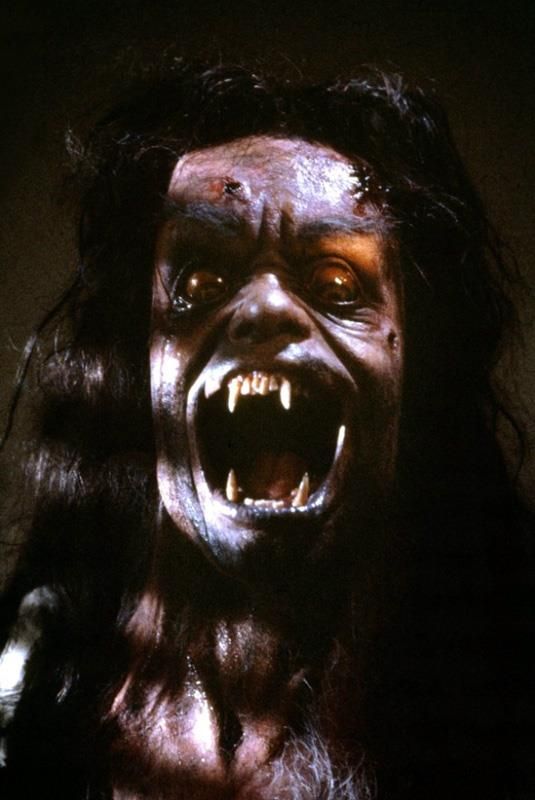
ALBERT MULLER
There are two movies I saw at around roughly the same time as a kid — I would have been about seven or so. I can never remember which I saw first, CREEPSHOW or THE HOWLING, but I do know that seeing those two so close together at that age changed my life forever. And to be sure, they both freaked me right the fuck out, but in a way that only made me want more horror movies and soon.
I’d have to give the edge to THE HOWLING, though. That’s the one I really remember. The one that’s stayed in my head all this time, almost forty years. I remember it so vividly; at a cousin’s house, and we watched a double feature of THE ROAD WARRIOR and THE HOWLING (this was clearly a big night for me). When Eddie Quist gave Karen a piece of his mind and then turned into a goddamn werewolf on camera, I was done. Crisped on a fresh grill done.
Every time I watch Joe Dante’s classic, I await that scene. When it comes, I smile like I’ve come home. It really is sort of just like that.
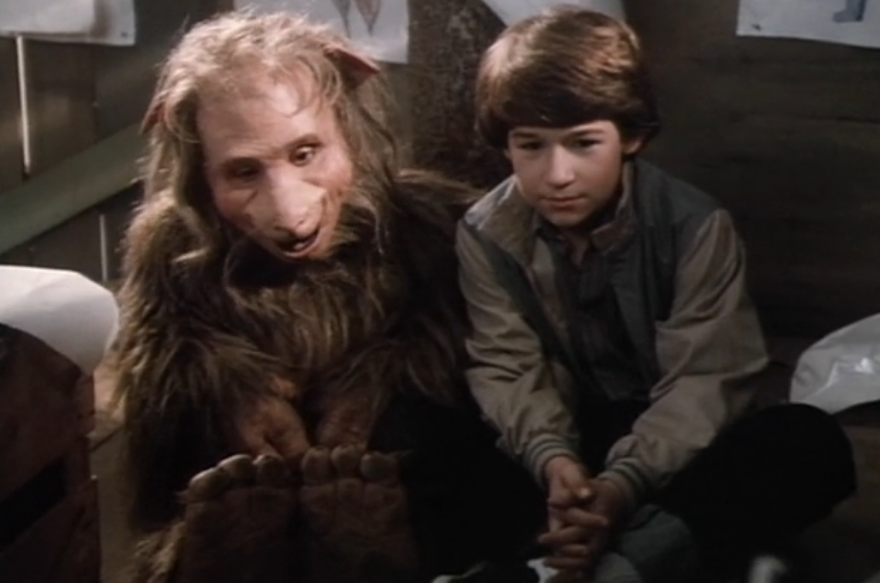
GG GRAHAM
Neither producer John Landis nor writer/director Mick Garris are known for family fare. However, the horror legends teamed up to create FUZZBUCKET for Disney in 1986. This made for TV film was originally aired as part of the Disney Sunday Movie anthology series, but I recall encountering it on a cheap corner store VHS.
Michael is a lonely 12 year old boy. He’s struggling with family issues and the looming start of junior high. Michael spends his days talking to an invisible friend he calls “Fuzzbucket.” For the first half of the film, the creature is assumed to be imaginary. Michael mixes a slurry of household ingredients and some mysterious green goo into a magic milkshake. Only then are we able to see the title character.
Initially played for heartwarming validation, the reveal introduces an utterly terrifying humanoid sheep. The creature is covered in shaggy fur, with a rat-like tail even David Cronenberg would find anatomically impossible. The newly visible Fuzzbucket punctuates his broken speech with some oddly hungry noises. These sounds are doubly disconcerting when you consider the creature’s disregard for personal space. Fuzzbucket constantly wants to hug or hold hands, grunting and slurping all the while.
This is all supposed to be a sweet parable about growing up and the value of friendship. However, when a misunderstanding brings Michael to Fuzzbucket’s underground home, no amount of uplifting music cues can disguise the terror of it all. There are tons more of the creatures lurking in the maze of caverns. The rest of the group is far from kindly towards human children. There is no obvious way out.
Only by the grace of his personal abomination does Michael get home safely. After Michael’s family does the obligatory kiss and make up routine, his parents retire to their room. Mystery gifts are lying on the dresser, which they assume are from Michael. Instead, the items are cheerful reminders from Fuzzbucket that he just broke into the family’s house. He skitters down the street, presumably to watch them from afar, as the credits roll.
I throughly checked my room that night for any glowing Fuzzbucket footprints. I also tended to avoid Disney properties for the remainder of my childhood. Instead, I returned to my usual habits of sneaking out of bed for the midnight movie and secret slasher viewings, both of which were far less disturbing.
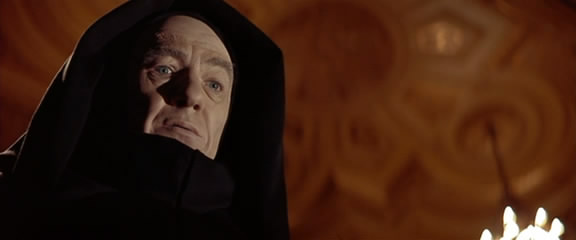
JUSTIN LaLIBERTY
When I was seven, I was allowed to see LAST ACTION HERO by myself shortly after being taken to see JURASSIC PARK and proving that I could handle seeing “intense” things in a theater (full disclosure, the intro of the T-Rex did scare me but I acted like it didn’t). I was already a fan of Arnold, parading around dressed like Terminator and quickly wearing out a tape of TERMINATOR 2. But none of that prepared me for how life changing, and terrifying, LAST ACTION HERO would be. Already cinema obsessed by second grade, I knew that I wanted to make movies when I grew up but LAST ACTION HERO made me want to work in a movie theater even moreso (which I later spent more than half of my life doing) except for one thing: the presence of Death.
For what appears to be a kids movie — or at least a movie prominently starring a kid that also had the coolest Burger King cup ever made — LAST ACTION HERO has a great amount of violence, enough that the original title of the film was EXTREMELY VIOLENT. Seemingly out of place for something that would carry a PG-13 rating, no? But despite the countless bodies (rather comedically) dispatched throughout, the terror comes in the form of Death — played by Sir Ian McKellen! — walking out of THE SEVENTH SEAL and into the real world. As a seven year old, I had no idea what THE SEVENTH SEAL was and the image of Death with his white face and scythe walking around amongst the mortals having leapt out of the screen gave me innate terror that the same thing could happen to me while seated in a theater. And that changed how I watched movies going forward, always anticipating that something horrible could leap from the screen and be seated next to — or worse, behind — me at any moment.
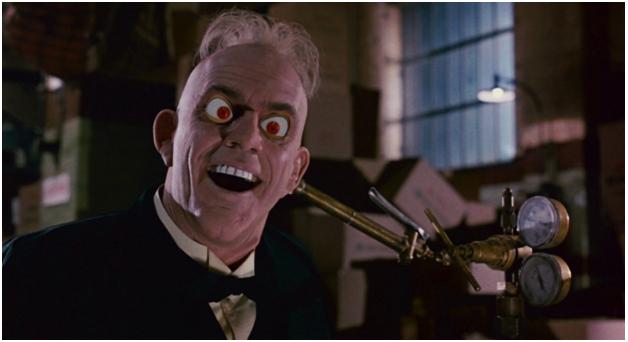
J. TONZELLI
Oh, give me a break. No contest. Judge Doom, as brought to manic life by Christopher Lloyd in WHO FRAMED ROGER RABBIT, is the stuff of kid nightmares. One of the all-time great movie villains, Judge Doom, in his all-black, Gestapo-like suit, is an eerie menace from his very first appearance in a 1947’s version of Los Angeles where “real” human beings coexist alongside walking cartoon characters. And he hates ‘toons. Vilifies them. Wants to dip them all in barrels of paint thinner (“the dip”) until nothing is left but colored grease. The evisceration and erasure of Toon Town. A full-on cartoon holocaust – that’s his endgame. That’s all bad enough.
And then the classic film’s lunatic finale happens.
Judge Doom is flattened under the wheels of a steamroller, only to resurrect, stick a gas tank nozzle into his mouth, and inflate his pancake body. His glass eyes pop out of his head to reveal he is, in fact, a ‘toon wearing a human façade. In pure, unfettered mania of which only Christopher Lloyd is capable, he embarks on a tirade in which he proudly, insanely, over-the-toply admits to Eddie Valiant (Bob Hoskins) that he was the one who killed Eddie’s brother – the crux of the movie’s conflict – and as his confession becomes more and more unhinged, his voice reaches a cartoonish high pitch like a whistling teapot before his cartoon eyes turn to daggers and springs burst from his feet, which he uses to launch across half a warehouse after a fleeing Eddie – and the whole time, his animated eyes are bubbling in his plastic face like a witch’s cauldron.
You know, for kids!
Watching WHO FRAMED ROGER RABBIT today, I’m still amazed director Robert Zemeckis was able to get away with the ghastly images that appear throughout the finale of his cleverly plotted CHINATOWN spoof. If the seed for horror hadn’t already been planted in my brain when I first saw it in my youth, then WHO FRAMED ROGER RABBIT was definitely one of the influences that cultivated it. (I also had an unhealthy crush on Jessica Rabbit, but that’s for another time.)

MARY KAY McBRAYER:
My older step-cousin Destiny was THE COOLEST. I would do anything I could to sit in her room in her parents’ mobile home while she told me about her collage wall shrine to Kurt Cobain or why she had a dismembered Barbie mobile in front of her bunk bed while No Doubt or The Offspring played on her stereo. Her hair was a different color every time I saw her, she said her godmother was Stevie Nicks, and she KILLED at Super Mario Bros. I wanted to be her so bad. She was eight years older than me, though, so when we watched the music video for Soundgarden’s “Black Hole Sun” on MTV, and that woman’s smile kept getting bigger and bigger while she chopped the head off that fish… it still fucks me up thinking about it. That smile is the reason why I will NEVER watch Truth or Dare. Your mouth is supposed to fit on your face!
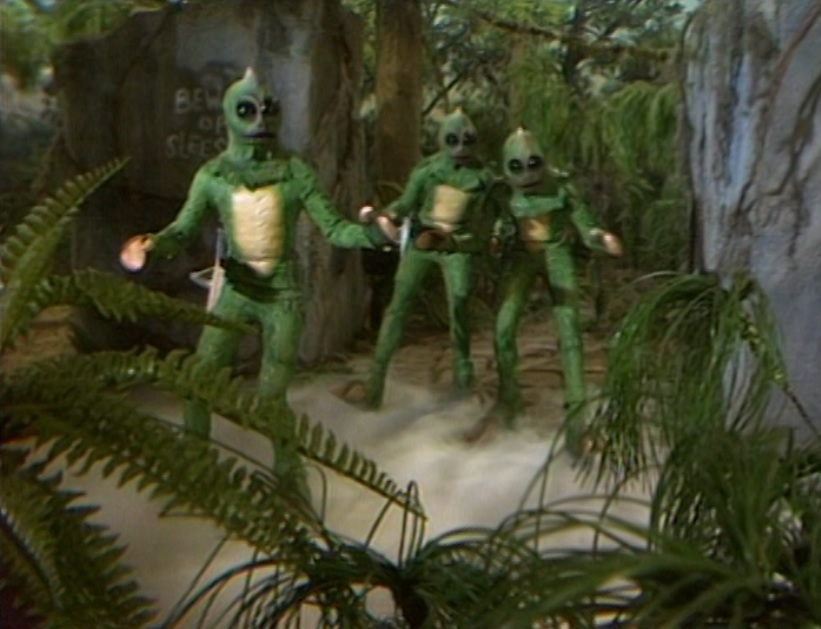
JEREMY LOWE
I’ve been a horror movie nerd about as far back as I can remember. So, to try and figure out some thing that scared me, let alone unintentionally scared me, was a bit of a feat. It took a bit of digging, but way back in my psyche I can remember what truly frightened me. It was those damn Sleestaks.
As a small kid, my older brother loved watching repeats of LAND OF THE LOST. It didn’t make sense to me. How does this family go from a camping trip to being thrown back in time. I dug the dinosaurs, what kid doesn’t love dinosaurs? If it was just dinosaurs, I would have loved the show. Unfortunately, Sid and Marty Kroft, the madmen and creative powerhouse behind making LAND OF THE LOST, weren’t happy with just dinosaurs. They just had to add in lizard-like humanoid monsters called Sleestaks.
Sleestaks scared the shit out of me. They weren’t especially violent, but they still haunted my dreams. Of course, my brother thought this was hilarious and teased me. I remember one Halloween when I was real young, my siblings took me to a house trick or treating where they knew the guy handing out candy was dressed as a Sleestak. They were surprised that I wasn’t frightened at all. It wasn’t until we got home that they realized my mask was on backwards and I couldn’t see a thing all night. Hey whatever works. I got the candy, and I didn’t have to deal with any damn Sleestaks.

GENA RADCLIFFE
Because I was such a high-strung, anxious child, everything scared me, at least a little bit. It made sense that JAWS, HALLOWEEN, and Ralphie Glick, the child vampire in SALEM’S LOT, were scary. Less easy to explain was why I so viscerally disliked the cover of Queen’s News of the World, or why whenever Gary Wright’s “Dream Weaver” came on the radio, I’d plug my fingers into my ears for the last two minutes. I get it now—it’s because the eerie instrumental closing sounds like the soundtrack for a slasher movie set in outer space. I doubt that was intentional on Wright’s part, but it’s the impression it leaves on me both now, and when I was a child, before I found the words to articulate what was so unsettling about it.
Such is the case with “The Great Piggy Bank Robbery,” a classic Looney Tunes cartoon parodying Dick Tracy. I was only dimly aware of who Dick Tracy was when I first saw it, and not at all aware of the passel of weird villains he regularly encountered on the job. All I knew was that there was something both funny, and deeply, inexplicably creepy about a guy with piano keys for teeth, a two-headed baseball player, and, of course, Neon Noodle, a Frankenstein’s Monster sculpted out of neon tubing. When they circle Daffy, there seems to be genuine menace in their intent, and my little six year-old brain didn’t know how to process it.
Now, of course, I realize that the word I was trying to grasp for was “grotesque.” Grotesque doesn’t necessarily mean scary, but rather weird, misshapen, wrong. Exacerbating this sense of wrongness is the animation itself, which plunges everything into darkness and shadow. Daffy is having a nightmare, and it looks like one. When Porky Pig shows up in a streetcar from out of nowhere to drive Daffy to the gangsters’ hideout (helpfully noted as “The Gangsters’ Hideout”), it feels a little bit like he’s driving him to Hell. “The Great Piggy Bank Robbery” wasn’t just a lot of young viewers’ first taste of film noir, it’s also an effective introduction to the idea of laughing at something while at the same time a chill runs almost imperceptibly down your spine.
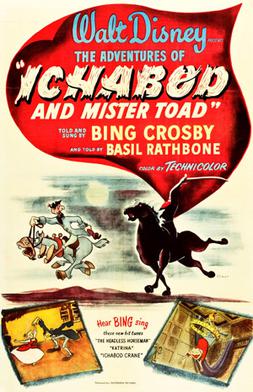
SCOTT DREBIT
Well, this certainly sounds like a pleasant little trip, doesn’t it? Perhaps two friends on a journey that just can’t be completed without teamwork and a positive attitude? After all, this was Disney in 1949, and they never peddled trauma, did they? Liars, the whole lot of them: First of all, it’s two short films combined, and second, I was six years old when I sat down in front of my grandparents’ TV and watched this on The Wonderful World of Disney. For the life of me I still have no idea about MR. TOAD, but I can sure regale you with my reaction to ICHABOD – I was terrified.
As a six year old tenderfoot, I knew not The Legend of Sleep Hollow by Washington Irving; my reading was strictly four colors and panels, not word after word on endless pages. Leave it to Disney then, to truncate the story down to 30-odd minutes with half of those dedicated to scaring the shit out of me.
The tale starts innocuous enough; Ichabod Crane is the new headmaster in the village of Sleepy Hollow, and he soon finds himself fancying a local girl. Another man, Brom Bones, also has eyes for the young lass, and tries to scare Ichabod away with the legend of The Headless Horseman, a fallen soldier who rides the woods at night looking for his misplaced cranium.
It’s when Ichabod heads home for the night that the terror was thrust upon me; ICHABOD (or THE LEGEND OF SLEEPY HOLLOW as it was known later when Disney split up the two short films) is built for suspense, no matter how innocuous it may seem to an adult; as Ichabod rides through the foreboding forest, he is met with strange noises that turn out to be harmless woodland creatures, until he comes upon him – The Headless Horseman.
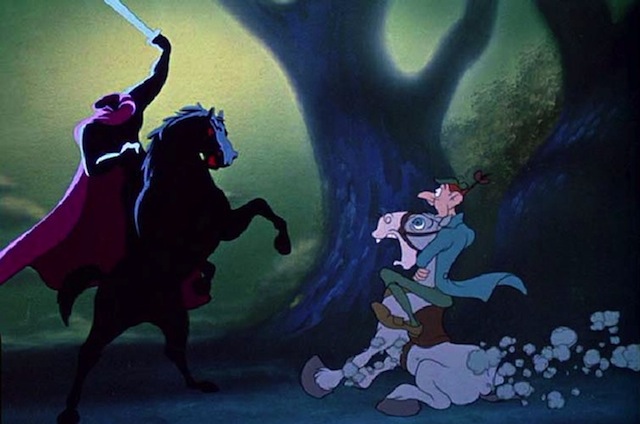
Friends, this was quite the sight at six; donned in black, on a black horse, carrying what appears to be a laughing, cackling jack o’ lantern. All with no head of course. HH chases Ichabod through the forest, and he almost makes his escape through the covered bridge, but is befallen to the horseman before that point. This is to say that the six year old nearly peed his pajamas as the grinning pumpkin made its way towards the screen; and to add injury to injury, Ichabod was never heard from again. So thank you Disney, for letting a little kid know that everything will not be all right, if even for thirty minutes.
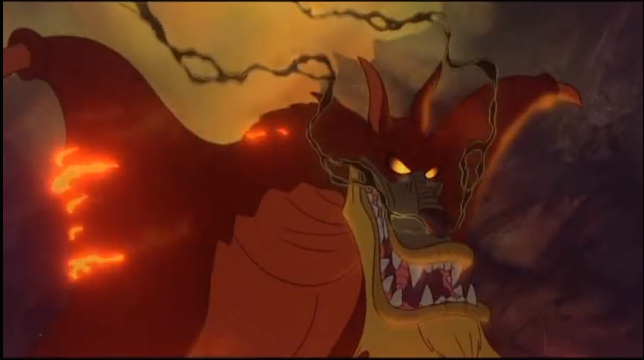
DANIELLE RYAN
There are quite a few troubling things in Don Bluth’s ALL DOGS GO TO HEAVEN, from the murder of Charlie Barkin (Burt Reynolds) to kidnapping and gambling as a major plot point. While I didn’t see the problem with any of these things as a child, what did bother me is a nightmare sequence Charlie has after he’s managed to escape heaven and kidnap the animal-whispering human child, Anne-Marie (Judith Barsi). After Charlie and Anne-Marie bring pizza and cake to a pack of orphaned puppies, Charlie goes off to rest. His sleep is interrupted by a terrible nightmare, in which he goes to hell and is being torn apart by demonic figures.
The hell imagery by itself was enough to freak me out as a young Catholic. Charlie sits on a gondola on a lake of fire. The gondola capsizes and he begins to sink into the lava, climbing higher and higher to try to get to safety. Instead of safety, he is beset upon by imps, who bite and tear at him while he screams.
Charlie wakes up right as he’s about to sink into the lava and realizes that the “imps” are the puppies biting at him to help him wake up. It’s a cute moment, but the nightmare always felt especially intense. The movie’s version of the Devil growls and calls for Charlie, and that gravelly voice frightened me through most of my childhood. While I heard stories about the fires of hell in church throughout my youth, I never had a fear of that place until ALL DOGS GO TO HEAVEN (and the last sequence in FANTASIA, but that’s kindertrauma for another time)!
JON ABRAMS
In the late 1970s, J.R.R. Tolkien’s prelude to The Lord Of The Rings was in the public domain. Arthur Rankin Jr., co-founder with Jules Bass of Rankin/Bass Productions, decided to adapt The Hobbit for television. Probably best known for stop-motion holiday specials such as Rudolph The Red-Nose Reindeer, Jack Frost, and MAD MONSTER PARTY?, the studio turned to Japanese animation house Topcraft, which later evolved into what we now know as Studio Ghibli, with Rankin supplying the production design and regular Rankin/Bass collaborators Romeo Muller supplying the script (which is ably condensed) and Maury Laws supplying the extremely effective music. So if you’ve ever watched THE HOBBIT and wondered why it plays halfway between Frosty The Snowman and a Hayao Miyazaki film, now you know.
Here’s the thing. Sometimes something gets lost in translation. And other times something unearthly and unholy is unearthed.
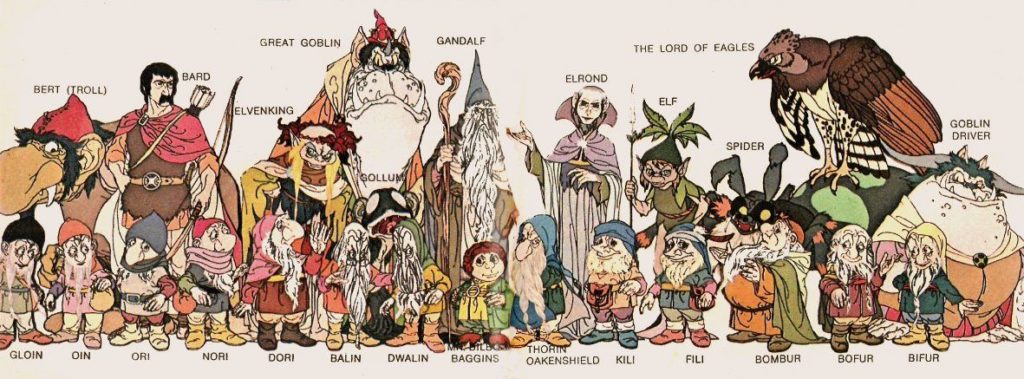
The character designs for THE HOBBIT are such that every single character is more upsetting than the one before it. The heroes all look three thousand years old and more fragile than glass. The trolls are noses with mouths. The goblins are mouths with limbs. The spiders have beards. How does a spider produce testosterone? The dragon has fur. How can something be a lizard and a dog (and a cat!) at the same time?
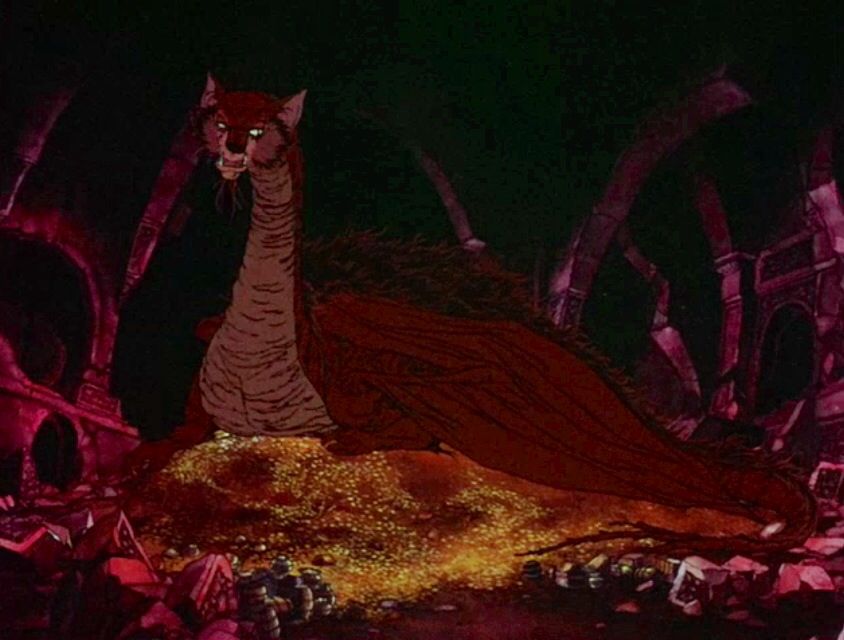
On top of everything, Rankin/Bass assembled arguably the single most bizarre voice cast for THE HOBBIT ever assembled for an animated film. I’m not saying it isn’t great. It’s just weird as shit. The American film director John Huston plays the role of Gandalf. The German film director Otto Preminger plays the king of the elves. Thurl Ravenscroft (the voice of Tony The Tiger and singer of “You’re A Mean One, Mr. Grinch”) supplies the singing voices for the goblins. The fact that this is a musical is disturbing on its own – it fits, since Tolkien’s novel is threaded with rhymes. But again, some sinister alchemy transpires between Tolkien’s verse and Maury Laws’ characteristically friendly songcraft. This, for example, is one of the most upsetting songs I’ve ever heard in my life.
As disturbing as every single character in THE HOBBIT is – no shit, every last one – the trophy, or the ring, has to go to Gollum. Take a look at this fucking thing please:
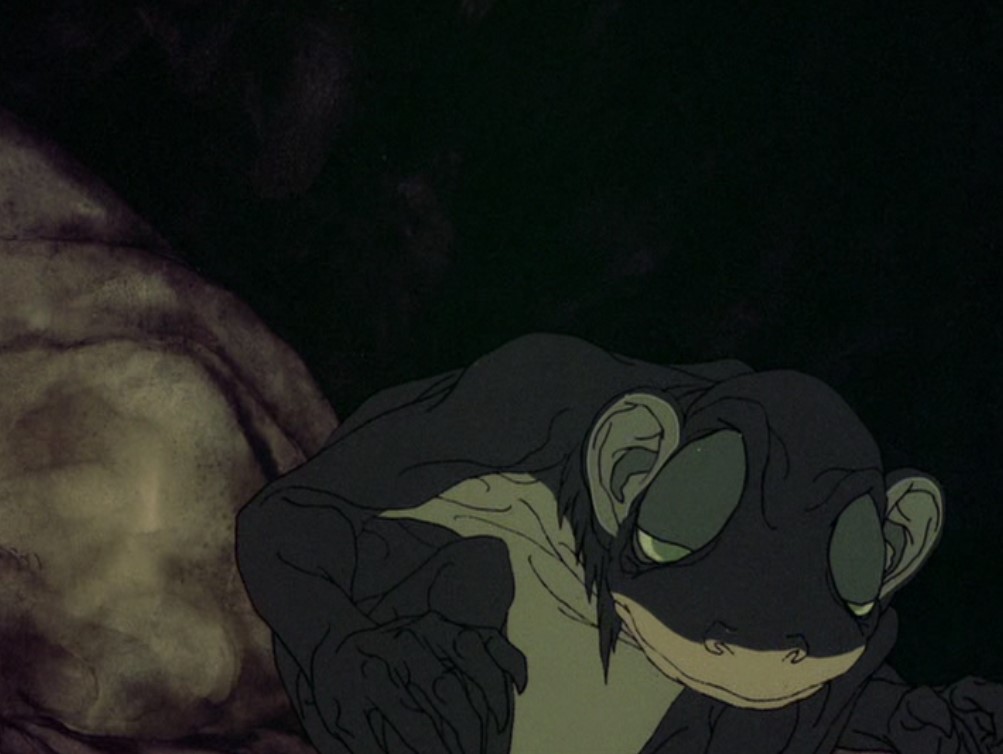
Gollum was voiced here by the performance artist Brother Theodore. (He was a regular on David Letterman’s show in the early 1980s and if you’re like me, you probably know him, though you never knew you knew him, from his role in THE ‘BURBS.) In performing a voice for Gollum, the unidentifiable creature who the title character, Bilbo Baggins, encounters in a cave where no light has entered maybe ever, Brother Theodore goes all the way in. He alternates between a rasp and a gurgle, except for the last moment of his scene, where he screams. The production doesn’t bother to hide his accent. “Why does Gollum sound so German?” is something I might have wondered as a kid. This movie provides no answers. When you’re a kid, that voice is a sound you’ve never fucking heard before, not even in your nightmares. To this date, it’s the rawest and most unnerving vocal performance in an animated film that I could possibly name. And the musical accompaniment by Maury Laws doesn’t help. The Gollum scenes have by far the creepiest accompaniment in the entire hour-plus running time of creepy accompaniments. (Imagine a young-adult Jonny A, then an ardent fan of underground rap, discovering Company Flow in the late 1990s and realizing that El-P, now famous for being one-half of Run The Jewels, sampled THE HOBBIT for one track, just to fuck with your head, son.)
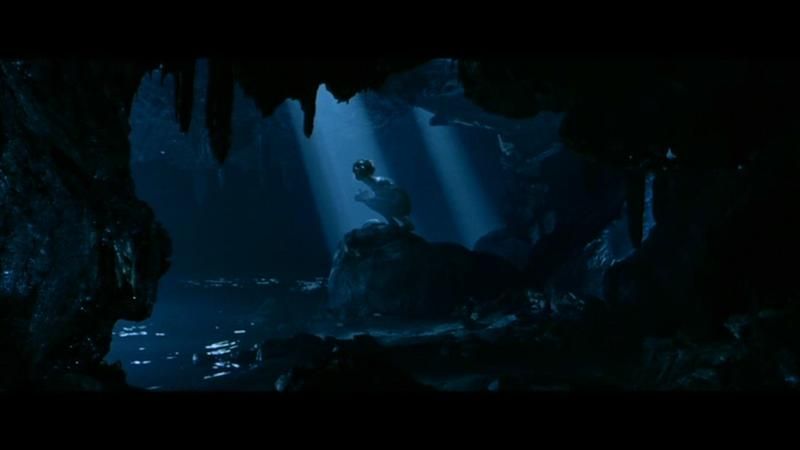
I understand that Peter Jackson’s rendition of Tolkien’s odyssey is now the primary visual touchstone for the property. I love it too, in so many ways and for so many reasons. But deep down, it’s always going to be just a little disappointing to me, because it just plain isn’t as scary. The performance by Andy Serkis, pioneering. The effects work by Weta Workshop, impeccable. But out of necessity, in order to make those movies the international smash success they had to be, Gollum had to be humanized, or Hobbit-ized. He was sympathetic, the trilogy’s most compelling character by far. Whatever I’m looking at in THE HOBBIT (1977), that isn’t sympathetic. That’s a monstrosity.
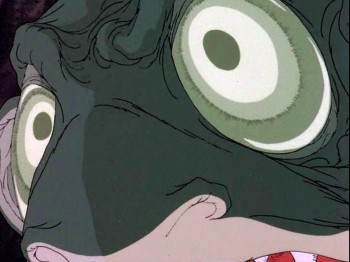
What can I tell you? I like the scary stuff. In my mind and in my nightmares, the character of Gollum will always sound like an elderly German Jew of indeterminate sanity and look like a dead salamander. Tolkien’s notion of a vicious creature who’s spent years and years alone in a dank cavern is haunting no matter what age you are, and the animated version of THE HOBBIT, to me, still conveys how horrible that existence must truly be.
Been thinking about this stuff for the past twenty minutes. Jesus Christ. pic.twitter.com/pBHCGM3HJD
— Jon Abrams ?? (@JonZilla___) April 5, 2017
- [THE BIG QUESTION] WHAT’S YOUR FAVORITE FEMALE ENSEMBLE IN MOVIES? - July 22, 2016
- [IN THEATERS NOW] THE BOY (2016) - January 24, 2016
- Cult Movie Mania Releases Lucio Fulci Limited Edition VHS Sets - January 5, 2016
Tags: Animation, Burt Reynolds, Childhood, Horror, Kids' movies






No Comments